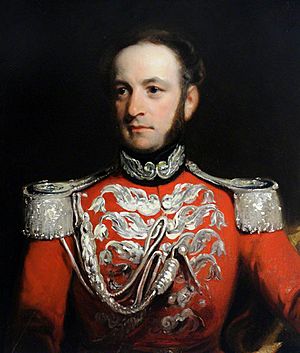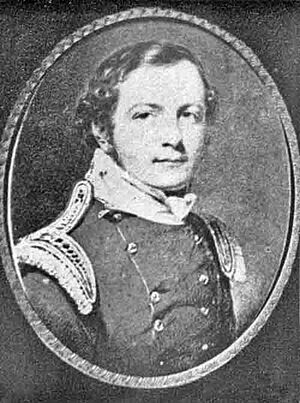John Le Couteur facts for kids
Quick facts for kids
John Le Couteur
|
|
|---|---|
 |
|
| Born | 21 October 1794 Saint Aubin, Jersey |
| Died | 24 December 1875 (aged 81) Saint Aubin, Jersey |
| Allegiance | United Kingdom |
| Service/ |
British Army |
| Rank | Colonel |
| Unit | 104th Regiment of Foot (New Brunswick Regiment) |
| Battles/wars | War of 1812 |
| Other work | Aide-de-camp for Jersey |
Colonel Sir John Le Couteur (born October 21, 1794 – died December 24, 1875) was a brave officer in the British Army. He also served as an important helper, called an Aide-de-camp, for King William IV and Queen Victoria in Jersey. John Le Couteur was the son of another military leader, Lieutenant General John Le Couteur. He is well-known for his detailed writings about his time as a soldier during the War of 1812. These writings were published later as a book called Merry Hearts Make Light Days.
Contents
A Soldier's Story
Joining the Army
In November 1811, when John Le Couteur was just 17 years old, he became a Lieutenant. He joined the 104th Regiment of Foot. His new unit was located far away in New Brunswick, a part of Canada.
The Great Winter March
During the War of 1812 between Britain and America, Le Couteur's regiment received a tough order. They had to march about 700 miles (1100 km) from Fredericton, New Brunswick, to Kingston in Upper Canada. This long journey was needed to help defend the area.
The march began on February 21, 1813, and lasted until April 12, 1813. The soldiers faced extremely cold winter weather. Temperatures dropped as low as -32°C (-27°F). It was a very difficult journey across rough land. Many soldiers suffered from frostbite because of the extreme cold. Le Couteur kept a detailed journal about this amazing march.
Battles and Skirmishes
After the long march, Le Couteur took part in many important fights. He was involved in the Siege of Fort Erie, where soldiers surrounded a fort to capture it. He also fought in the battles of Sackett's Harbour and Lundy's Lane. In total, he was part of thirty-three smaller fights, known as skirmishes.
In his journal, Le Couteur wrote about the brave First Nation allies who fought alongside the British. He admired their courage.
After the War
After the War of 1812 ended, Le Couteur continued his military career. In 1816, he became an Aide-de-camp to his father, Lieutenant-General John Le Couteur, in Curaçao. He returned to Canada the next year. In 1818, his regiment was disbanded, and he moved back to Jersey.
Life in Jersey
Family and Local Roles
When Le Couteur returned to Jersey, he was a captain. He married his cousin, Harriet Janvrin. They had two sons and three daughters.
In 1829, he became a Colonel in the West Regiment of the local Militia. He also held important public jobs in Jersey. In 1826, he was elected as the Connétable (a type of mayor) for Saint Brélade. In 1835, he became a Jurat, which is a judge in Jersey's Royal Court.
Serving the Monarchy
In 1831, Le Couteur was appointed Aide-de-camp to King William IV. This important role was renewed when Queen Victoria became queen in 1837. Queen Victoria even visited Jersey in 1846. Le Couteur continued to serve as Aide-de-camp until 1872. In the same year, he was given the title of Knight, becoming "Sir John Le Couteur."
A Scientist and Writer
Studying Wheat
Sir John Le Couteur had many different interests. He was also a talented artist. He spent a lot of time studying wheat in a scientific way. He wrote several books about farming, including:
- On the Varieties, Properties, and Classification of Wheat (1836)
- On the Use of the Jersey Trench Plough (1842)
- On the Rise, Progress and State of Agriculture in Jersey (1852)
Because of his important research, Le Couteur was chosen to be a Fellow of the Royal Society in 1843. This is a very high honor for scientists.
His Writings and Legacy
Le Couteur wrote a lot throughout his life. His many papers are kept safe by the Société Jersiaise in Saint Helier. Some of his writings were published in a book called Victorian voices in 1969.
His detailed memories of the War of 1812 were edited by historian Donald E. Graves. They were published in 1993 as Merry Hearts Make Light Days.
Le Couteur's story also gained new attention in Canada and Jersey. His account of the 104th Regiment's 1813 winter march was made into a short film in 2013. The film was called The Winter March. This project won a student contest and was shown at the Toronto International Film Festival.


